A strong SEO strategy that drives industry authority, brand visibility and organic web traffic is critical to the success of companies in the SaaS industry. What is the key to correctly performing SEO? Why is SEO for a SaaS company different from SEO for so many other types of companies? We’ve put together an infographic to ensure you don’t overlook any SEO essentials.

When it comes to developing your SaaS business, adding SEO to the mix is perhaps the most important thing you need to consider. While you can always deploy PPC ads to achieve good results, SEO brings you a golden opportunity to achieve long-term results at much lower costs.
Considering the fact that nearly 93% of all web traffic originates from search engines, it can be surely said that a large number of your prospective customers are using one of them to find solutions to their problems.
But, the question is which SEO strategies you should follow to set your SaaS business apart from its competitors? To help you out, we’ve created this SaaS SEO checklist that contains the most effective, actionable strategies to take your SaaS business to the next level using SEO.
SaaS SEO Basics
Setting up Google Search Console
If you don’t know the way your site performs in Google searches, it’s almost impossible to devise the right SaaS SEO strategy. And that’s where Google Search Console can help you out. This free web service offered by Google helps you measure your site’s traffic, monitor keyword performance, and troubleshoot issues.
Setting up Google Analytics
Google Analytics is another free analytics tool from Google that lets you track the sources of your site visitors and analyze their interaction with your site. Based on the data provided by Google Analytics, not only can you assess the effectiveness of your marketing efforts but also optimize your site’s performance to get the most out of them.
Setting Up SEO-Friendly Architecture
Simply put, site architecture is how your site’s pages are organized and linked together. If your pages take several clicks from the homepage or aren’t properly linked, it’ll be difficult for Google crawlers to find and index them, and the end result will most likely be poor rankings in the SERPs.
You can stay away from this problem by making sure that all pages are within three clicks from the home page, as shown in the above image.
Removing Duplicate Content
If you’ve got multiple similar or identical pages, it can confuse Googlebot and damage their rankings. Ideally, you should avoid having similar sections of content throughout the site. However, if you must use them for different purposes, use a canonical tag that defines the master version of a page and pages similar to it.
Submitting a Sitemap
The objective of doing this is to help search engine crawlers understand and locate the web pages they should crawl and index. If you’re using Yoast or Rank Math, you can get a sitemap readily available and live, meaning you only need to submit it within Google Search Console. Or else, you can use XML Sitemaps Generator to generate one.
Creating a Robots.txt File
A robots.txt file instructs crawlers how they need to crawl your site. You can use it to tell crawlers which pages they should crawl and which ones they shouldn’t. If you’re using WordPress, you can update the robots.txt file using Yoast or Rank Math. Otherwise, you need to create it manually within your https://www.domain.com/robots.txt.
SaaS Keyword Research
Finding the right keywords is what builds the foundation of SaaS SEO. In terms of SaaS SEO, you need to target two types of keywords: informational keywords (used by searchers to obtain information) and transactional keywords (used by prospective customers to buy a service).
Here’re four highly effective methods to generate these keywords.
Keyword Research Using Google Keyword Planner
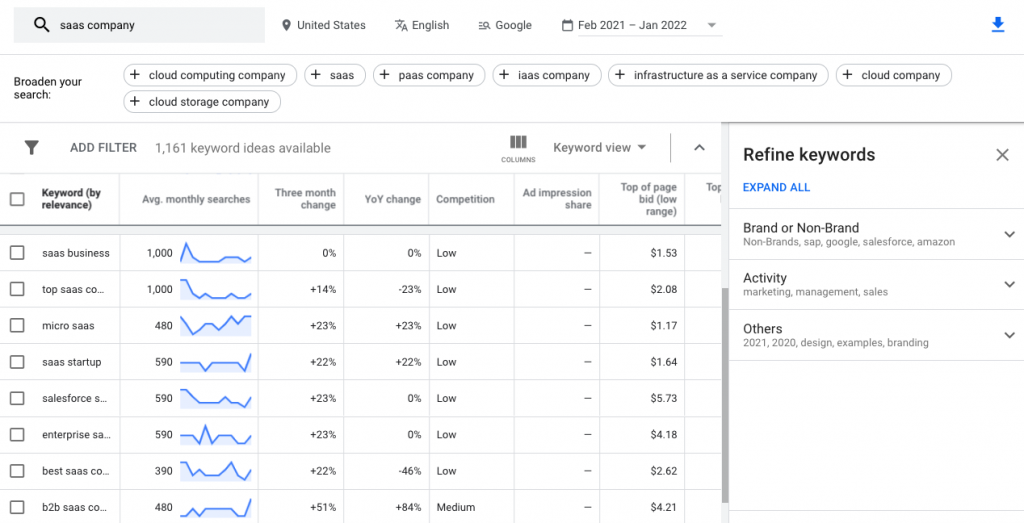
Google Keyword Planner is a free tool designed to help you identify relevant keywords along with valuable data about them, including monthly search volume and competition. First, you need to brainstorm some keywords relevant to your service and type them in the Keyword Planner. The tool will show you their insights together with a list of related keywords.
Note that the broadness of your initial keywords will determine the number of suggestions you’ll see. If you enter a broader keyword, you’ll get more suggestions. On the contrary, if you enter a too specific keyword, the number of suggestions will be pretty low. So, it’s vital to maintain a balance when entering the initial keywords.
Keyword Research Using Ubersuggest
Once you’ve got an initial idea about what keywords to target for your SaaS business, it’s time to identify more specific keyword ideas. For instance, we’ve entered a broader term “SaaS” in Ubersuggest and it showed the following:
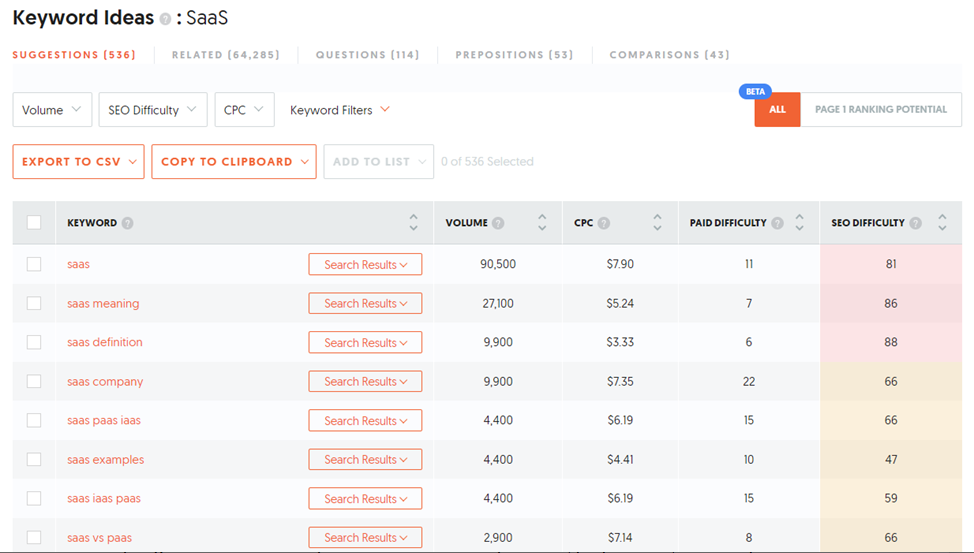
Image: https://app.neilpatel.com/en/ubersuggest/
As you can see, we got many long-tail versions of “SaaS” that we typed in along with their monthly search volume, CPC, PPC difficulty, and SEO competition.
One cool feature that helps Ubersuggest stand out from other keyword research tools is its ability to generate different keyword ideas based on questions, prepositions, and comparisons.
Keyword Research Using Competitor Analysis
Analyzing the keywords your competitors are ranking for is another effective idea to build your own list of relevant keywords. However, considering that not each of your competitors is using SaaS SEO, you should first identify the top two or three companies that are using keywords relevant to your software.
Once you’ve identified the companies, use an SEO tool such as SEMrush or Ahrefs to pinpoint the keywords they’re presently ranking for. After the tool has generated a list of keywords, browse it and choose the ones most relevant to your software.
Creating a Keyword Sheet
Now that you’ve got a large number of relevant keywords using the above strategies, you should create a keyword research sheet that you’ll be using for all your further keyword-based optimizations. Here’re the things you should include in the keyword sheet.
- Your target keywords.
- Their individual monthly search volume.
- Segmentation of the keywords based on priorities. This should be distributed in high-priority, medium-priority, and low-priority keywords.
- The status of each keyword. This includes whether or not a keyword has already been used and its present stage in the utilization process.
- Inter-related pieces of content (topic clusters) being developed using the keywords.
- CPC (cost-per-click) of each keyword.
On-Page SaaS SEO
Here’re four strategies to help boost your site’s on-page SEO performance.
Using Short URLs
All of your page’s URLs need to be easy for search engines to find and understand. Using overly complex and too long URLs will ultimately harm your pages’ rankings in the SERPs. Users may also break the links unintentionally, leading to the URLs not working, which results in a poor user experience.
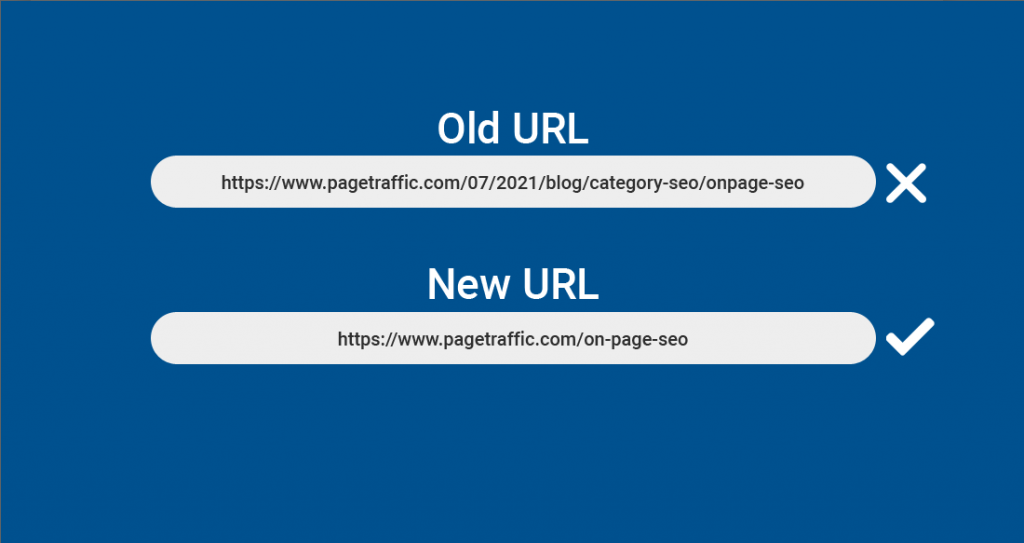
To create short and user- and search engine-friendly URLs, include explanatory keywords that provide additional information about a particular page. Avoid using numbers, dashes, or hyphens in your main URL domain. It’s also important to make the URLs consistent with the pages’ H1 headers. Lastly, don’t use dynamic URLs as they may trigger problems with crawling and indexing the pages.
Optimizing Title Tags and Meta Descriptions
Both the title tag as well as meta description are two fundamental aspects of on-page SEO.
When optimizing title tags, be sure to incorporate searcher intent keywords, which you’ve generated from keyword research, to serve your users’ specific purposes. The title tags also need to include the topics of the associated pages and the same vital keywords that you’ve used in the pages’ copy, URL, meta description, and image alt attribute.
When optimizing meta descriptions, be sure to keep the length within 160 characters, include your primary keyword, use a call-to-action, make them actionable, and mention what the page is all about.
Optimizing Images
First, you need to include images relevant to the subject you’re talking about. Second, use your primary keyword in an image’s file name to help the search engines understand it. Next comes choosing the right image format. Choose between JPEG (provides good results using a smaller file size) and PNG (ideal for preserving background transparency using a larger file size).
It’s also important to reduce the images using a tool like TinyPNG or a WordPress plugin like WP Smush. Finally, add appropriate alt tags that describe the content of images, which can help your site get better rankings in the SERPs.
You can read a detailed post on image optimization here.
Fixing Keyword Cannibalization Issues
Targeting the same keyword to rank multiple pages may harm the performance of the keyword, which is called the keyword cannibalization issue. This leads to multiple negative consequences, including a reduction in the page authority, its value, and a fluctuation in its SERP rankings.
To fix keyword cannibalization issues, first create a list of all your URLs and the keywords associated with them. If you find any duplicate entries, particularly among core pages, fix them immediately. You can use several techniques, including creating new landing pages, finding new keywords, consolidating multiple pages (if they aren’t unique enough) into one, and using 301 redirects.
Content Optimization
Creating high-value content isn’t going to help you in terms of SEO benefits unless you optimize it. In simple words, content optimization is about making your SaaS site’s content optimized for the search engines.
Let’s see some useful methods to achieve this goal.
Using Skyscraper Technique
To implement this technique, first you need to find a successful piece of content relevant to your industry. Then you need to create something better than that and, finally, promote the new piece as much as you can.
When done well, the skyscraper technique can greatly help boost your site’s rankings. However, you need to consider the following factors when creating the new piece:
- The original piece needs to be in high demand, which means the audience will likely accept the new piece.
- You must create a unique angle or add something new that helps the readers learn something new.
Creating In-Depth Content
In-depth content refers to the pieces that are comprehensive and high-quality. This means you should create content that’s original, extremely thorough, and provides well-researched information. The piece shouldn’t focus on selling your services or business. Instead, it needs to include valuable information from authoritative sources.
So, rather than writing something like “3 Steps to Build a SaaS Application,” you may want to create something like “A Comprehensive Guide to Building a SaaS Application,” which discusses all the steps in the process. This kind of content typically remains evergreen, providing value to the readers over the years.
Publishing Up-To-Date Content
When you update your pages frequently with high-quality content, the chances of those pages getting higher rankings become pretty high. The reason is when you update your site with fresh content, the search engines visit it more frequently, giving it the opportunity to get higher rankings depending on the quality of the content.
Incorporating valuable, relevant keywords in your content also helps you in driving more traffic to your site, and when your visitors’ dwell time increases, it helps to improve your site’s rankings. Lastly, frequently added fresh content gives you the opportunity to become an industry authority in search engines’ eyes.
Focusing On Better Readability
Will you like to read content that’s hard to follow or boring? Certainly not! You need to consider exactly the same thing when creating content for your audience. Each piece of your content should be aimed at providing your visitors with a great reading experience.
To improve readability of your text,use short sentences as much as possible. It’s also important to avoid complicated sentences, difficult words, and passive voice. You should also try to write the pieces in an appealing tone while adding transition words. To check the readability of the text, you can use Yoast SEO’s readability analysis.
Using Images and Videos
Eye-catching visual content naturally attracts and captivates visitors, giving them a clearer understanding of both the message and what’s behind it. Also, it becomes much easier for the readers to remember content with visuals than content with only words.
When it comes to adding images, it’s a must to use high-quality images that are contextually relevant to your content. When you want to demonstrate how effective your solution is, adding a video is the best method to do it. However, to leverage this technique, your videos have to be engaging, entertaining, educational and need to resonate with your brand characteristics.
Optimization of internal links
Though the weightage of internal links isn’t as much as external backlinks, they’re nevertheless crucial for the success of your SaaS SEO. To optimize your internal links, you should conduct a site audit to find broken internal links and fix them by either removing the dead link or updating the target URL.
If your website has orphaned site pages with no incoming internal links, you should ensure that every page has at least one internal page linking back to it. As a SaaS business owner, you may want to use internal links to join your top solutions pages. When creating new content, you can refer to other pages or articles that are topically related to your present piece. Whenever possible, try to incorporate your target keywords as anchor texts.
When relevant and popular sites in your niche link back to your home page, they pass along link juice. You can distribute it around your site with smart linking to other internal pages, thus helping them be found by search engine crawlers. Even when you create new web pages, you can pass along the link juice gathered from your other relevant pages to it with smart internal linking.
Your internal links should be placed on relevant pages. Though you don’t need to follow a cluster or silo model to the T, you should ensure the pages based on a similar topic are connected together via internal links.
To preserve link equity, you should limit the facets you add to your navigation. In other words, you need to restrict your faceted navigation. Additionally, you should remove redirects that weaken your link equity.
Technical SaaS SEO
Technical SEO helps to ensure that search engines can easily understand and rank your SaaS site and it remains easy to navigate for your users. You can use these tried and tested technical SEO tips to optimize your site’s infrastructure and attract more traffic.
Using 301 Redirects
The objective of using a 301 redirect is to notify the browser that a page has permanently moved to a new location so that it can send the users there. You can use them when redirecting dynamic URLs to their search engine-friendly versions, moving to a new domain, and preventing duplicate content issues.
The simplest way to implement a 301 redirect is to edit the .htaccess file of your site. If you’re using WordPress, you can use the free Redirection plugin to add 301 redirects.
Improving the Page Load Speed
Page speed has been a key ranking factor for Google since 2010, and it introduced the “Speed” update to prioritize the importance of page speed. If you’re wondering how a poor page load speed affects your site, take a look at the below statistics.
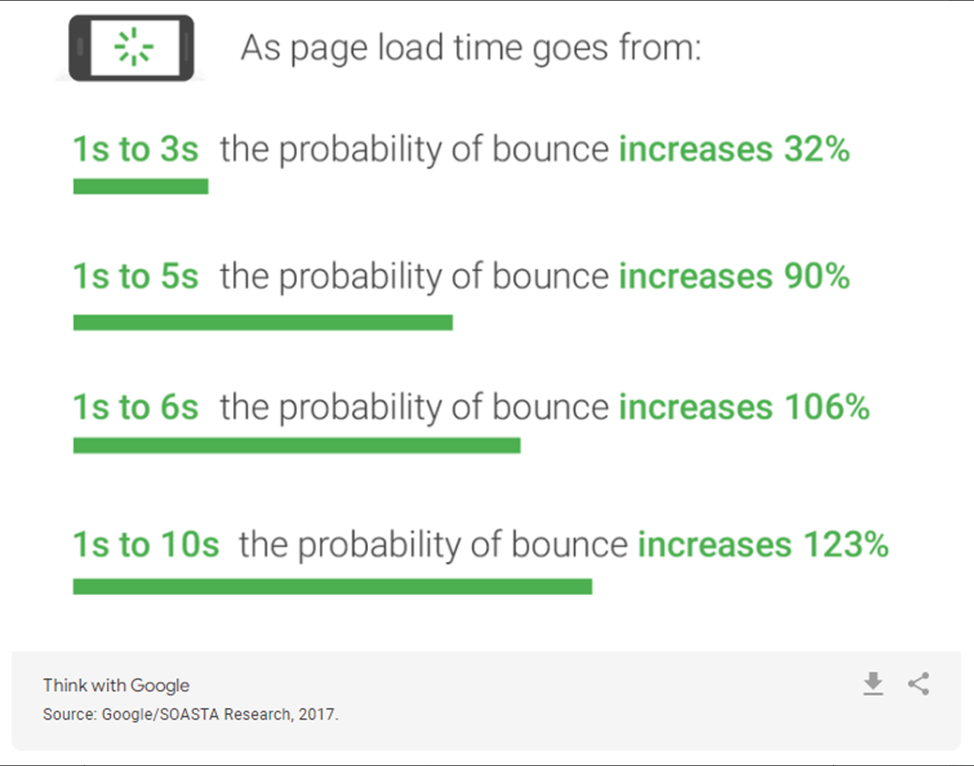
Image: https://www.thinkwithgoogle.com/
There are several methods to improve page load speed. Some of the most common ones include compressing and optimizing your images, switching to a performance-optimized hosting solution, caching your web pages, enabling browser caching, and reducing the redirects.
Creating the Right URL Structure
It’s important to create properly-formatted, SEO-friendly URL structures to help both your users and search engines understand them. It helps to improve both your site’s user experience and its rankings in the SERPs.
The first thing you need to focus on is creating a simple and logical URL structure. Also, try to include meaningful keywords, eliminate stop words, use lowercase words, and eliminate dates from blog posts. Be sure to add a 301 redirect whenever you change or edit a URL so that users are redirected to the new URL.
Using Schema Markup
Schema markup (also called structured data) helps the search engines understand your site’s content. This, in turn, not only helps them provide more accurate information to their users but also your site in ranking better for different kinds of content and getting more visibility.
While there are many different markup types that can be found, some common ones include organization schema markup, local business schema markup, article schema markup, recipe schema markup, event schema markup, and rating/review schema markup.
Enhancing Site Security
No matter how outstanding your site’s content is, if it isn’t secure, it’ll damage your site’s rankings. Moreover, recuperating trust is one of the key obstacles to conversion from both present and future consumers, meaning if your site experiences some kind of lack of security, the impact could be massive.
To bolster your site’s security, you can do several things, including switching to HTTPS, taking additional measures to enhance the level of protection of your payment processing program, using a web application firewall, restricting file permission, and limiting access to certain directories.
If you’re planning to switch to HTTPS, read our in-depth guide on migrating from HTTP to HTTPS to master the process.
Ensuring Mobile-Friendliness of the Site
With mobile device usage skyrocketing in recent years, it has become a must for business websites to be mobile-friendly. Google also prioritizes mobile sites when it comes to crawling and indexing websites. First, test your site’s mobile-friendliness by using Google’s Mobile-Friendly Test tool.
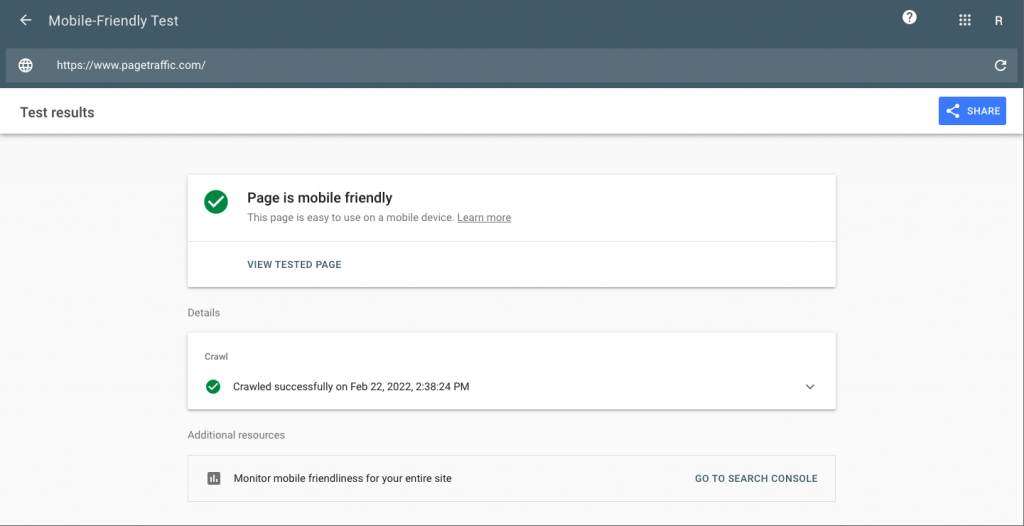
If it isn’t, integrate a responsive design first. Then, focus on improving the user experience by implementing easy-to-find CTAs, making fonts readable on smaller devices, limiting the use of pop-ups, and implementing an easy-to-use navigation bar. Creating a separate mobile URL is also another effective way to serve mobile users.
Fixing 404 Errors
Your users receive a 404 error when they want to access one of your pages but it cannot be found on your server. This not only negatively affects the user experience but your site’s rankings as well. Two common reasons that trigger a 404 error include deleting a page from the website and moving a page to another URL.
To fix a 404 error, you can redirect the page using a 301 redirect and restore deleted pages.
Off-Page SaaS SEO
Off-page SEO refers to activities performed outside of your SaaS website and mainly involves link building tactics. You can use these proven tactics to acquire backlinks.
Guest Posting
You’ll need to find other publications or companies that accept guest posts and pitch them an idea for a post that’s relevant to their target audience. If it’s approved, you’ll write it and get it published on the publication’s or company’s website with a link back to your own SaaS site.
To find guest posting opportunities, you can run Google online searches and reverse-engineer competitor backlink profiles. You may even reverse-engineer individual authors to locate the websites they’re submitting their guest posts to, for prospecting if they’ll be interested in getting written contributions from you too.
Podcasting
Just like guest posting, podcasts too can be a great source to get backlinks from. They are effective ways to talk to a broader audience about your SaaS product that’s making a significant difference in your target users’ lives. You could even use podcasts to talk about your innovative ideas or interesting case studies in the field of SaaS.
Though some podcasts are hosted on iTunes and Google Podcasts, most are housed on their websites and have transcripts. Thus, by reaching out to such websites and letting them know you want to be interviewed, you can earn a backlink in the podcast description if they accept your proposal. This will boost your online brand presence and help you get better search engine rankings.
Broken Link Building
No one prefers to have broken links on their websites. Yet, you’ll find several resource pages and websites linking out to resources that don’t exist anymore. If you locate a broken link on a website that’s relevant to your target niche, you can bring the non-functional link to the webmaster’s attention and ask if the person would like to link to your content instead.
This will help these webmasters replace their broken links with a recent and relevant piece of content, while you’ll earn a backlink in the process.
Link Intersect
To examine if you aren’t aware of link building opportunities that your competitors are cashing upon, you need to do the link intersect analysis to check if your competitors are getting backlinks from the domains you plan to target.
If they are, you’ll have a higher probability of getting backlinks from them. Once you have prepared a list of these potential link building opportunities, you should reach out to them to find out if they’re willing to give you backlinks. This strategy is quite helpful in revealing quick-win link building opportunities for you to cash in on.
Design Link-worthy Assets
From creating infographics, videos, and images to charts and visual content, you’ll need to create a diverse range of content that’s worth linking to. To make your content link-worthy, it should be non-promotional and audience-focused, apart from being well-researched and having in-depth information.
Additionally, if you can ensure it offers the readers useful takeaways, such as actionable tips and tricks or answers to their pain points, it’ll be more likely to get shared and linked back to. Though content focused on current events can attract links, evergreen content is more prone to get you long-term, high-quality backlinks.
Product Roundups
They can be an excellent approach for your SaaS products. And the best part? You’ll get a backlink as well as significant exposure. To make the best of product roundups, you’ll first need to find articles that list the “top 10” or “best products” for your niche.
Next, you can get in touch with the article’s author to provide them with your product’s brief sketch and tell precisely why it deserves a place on the list. If you have got a great product and can put forward a convincing pitch, you could land a significant number of backlinks, along with brand recognition.
The key to success in search engine optimization is paying attention not only to the strategies you use, but also when and where they apply. The goal of this checklist is to help you understand SEO for SaaS and to use it to grow your SaaS company. With this SEO checklist, you’ll have all the information necessary to optimize your site for Google. Go ahead…start ranking!
























